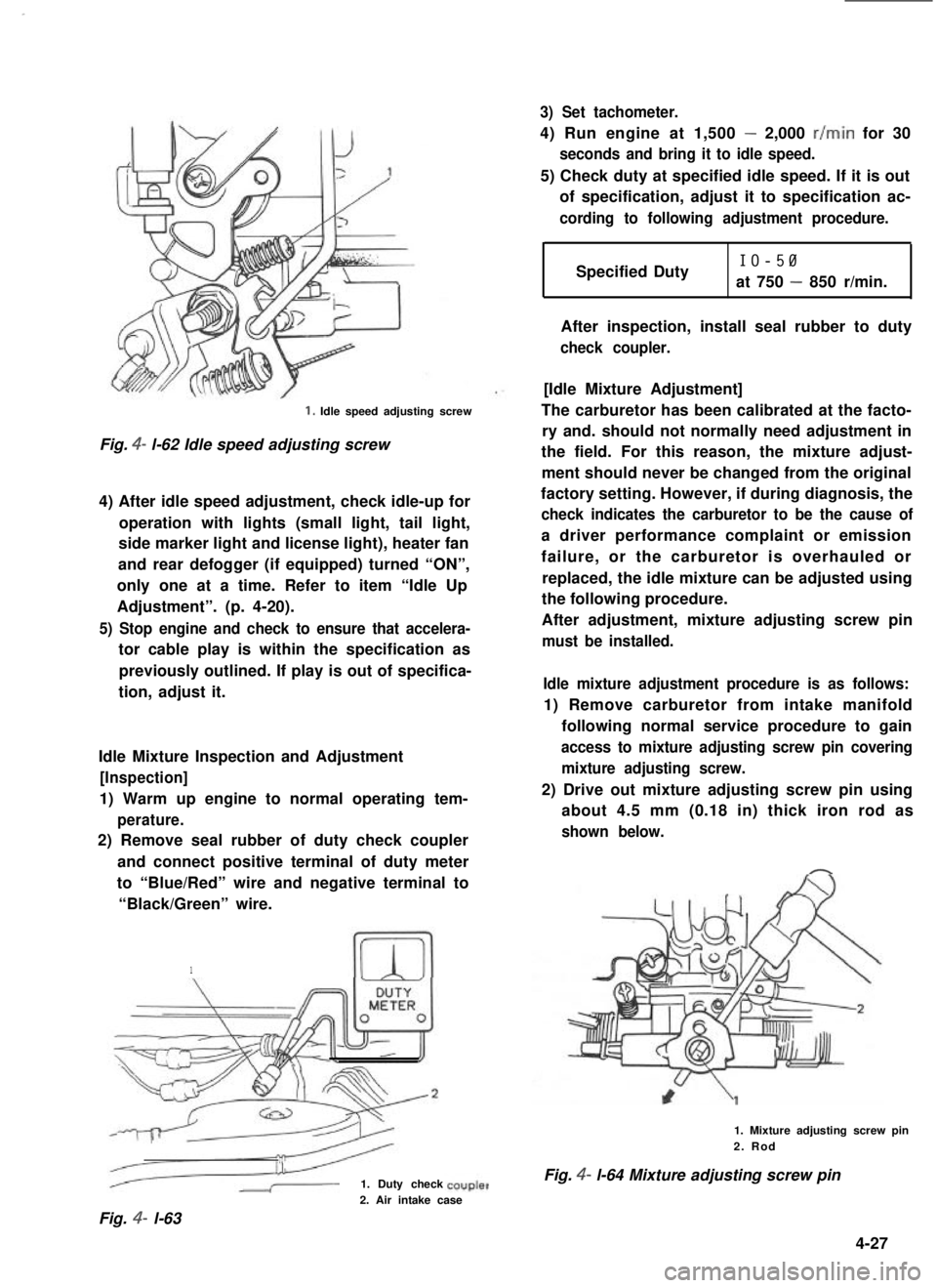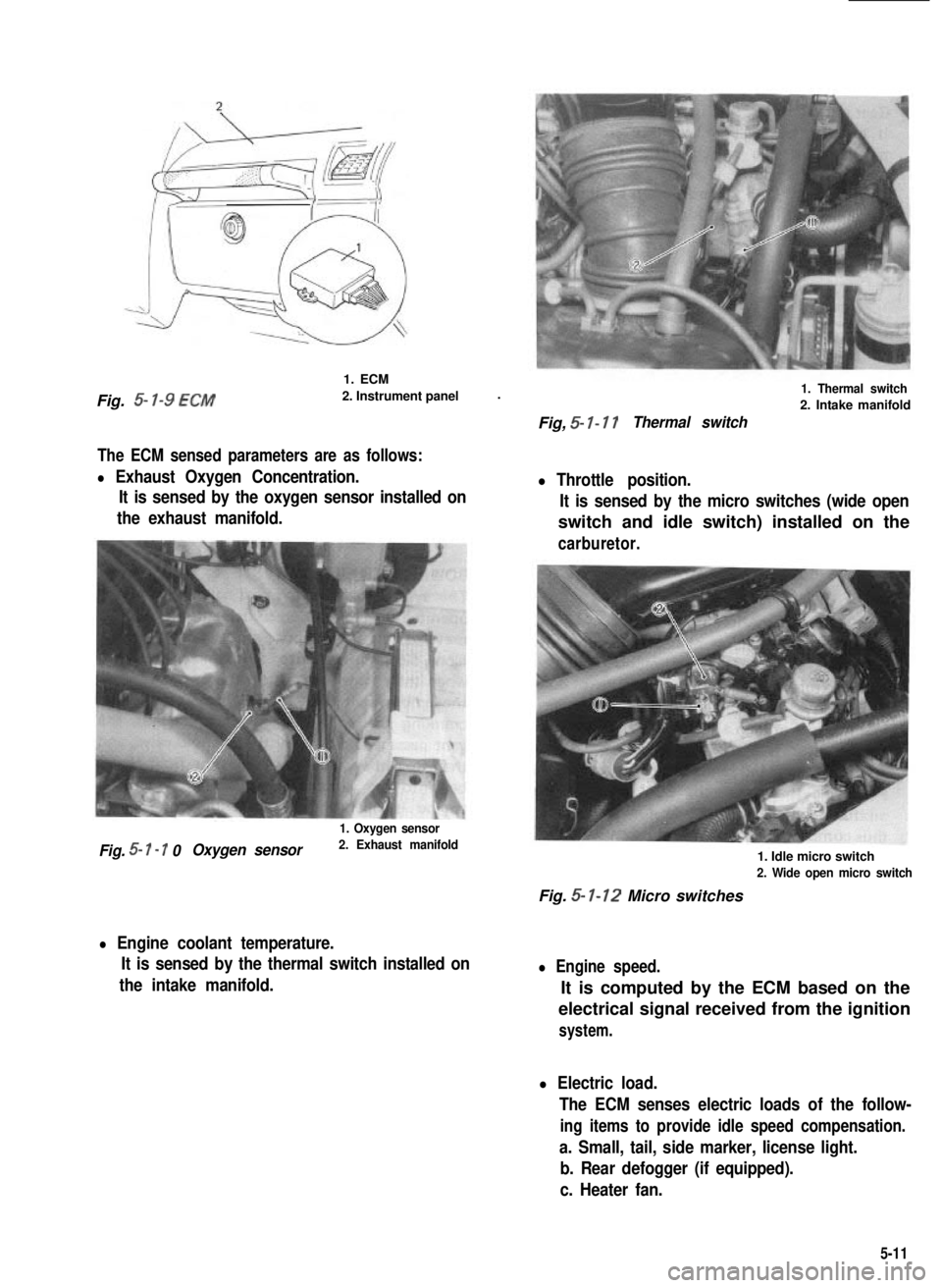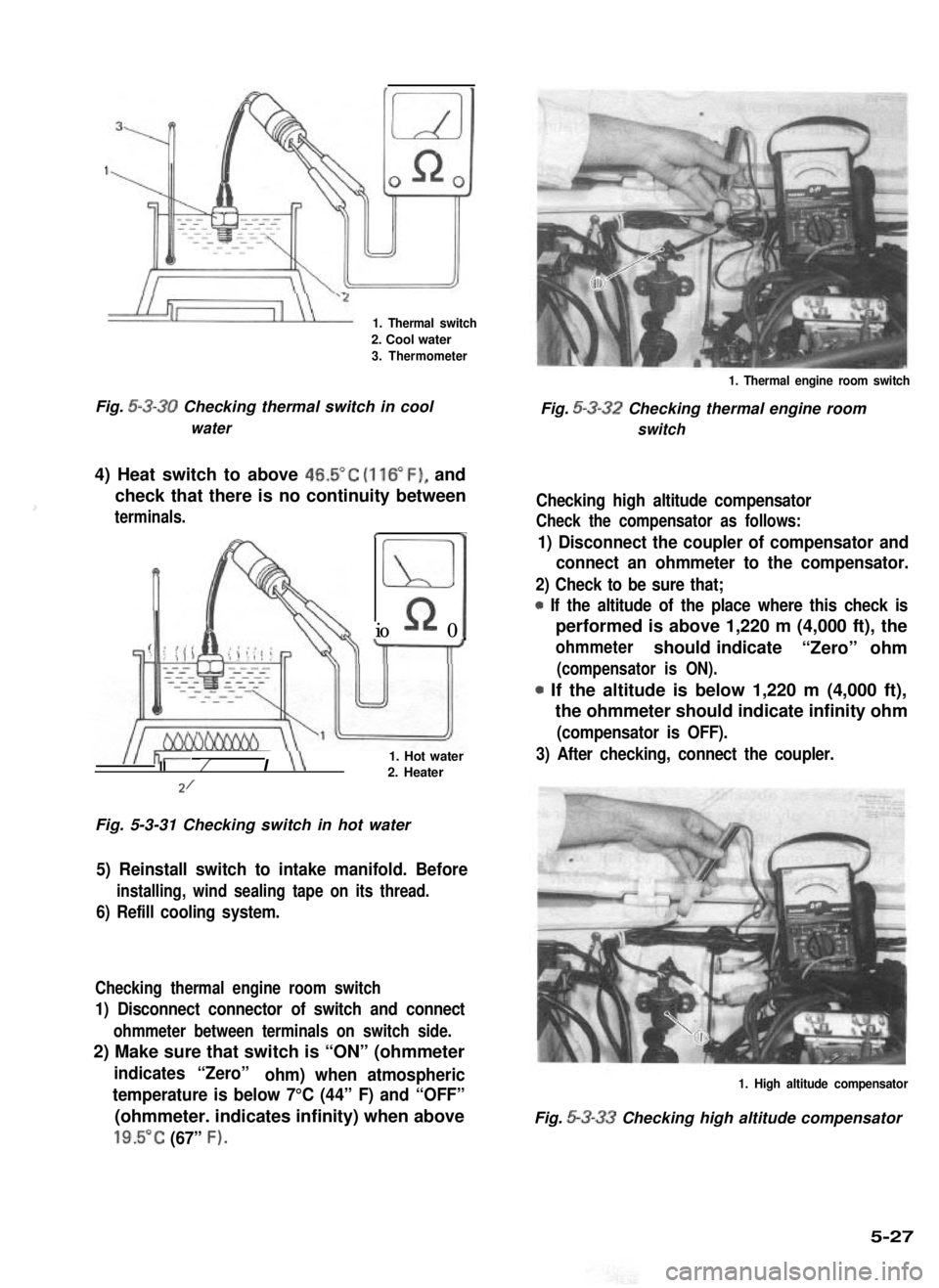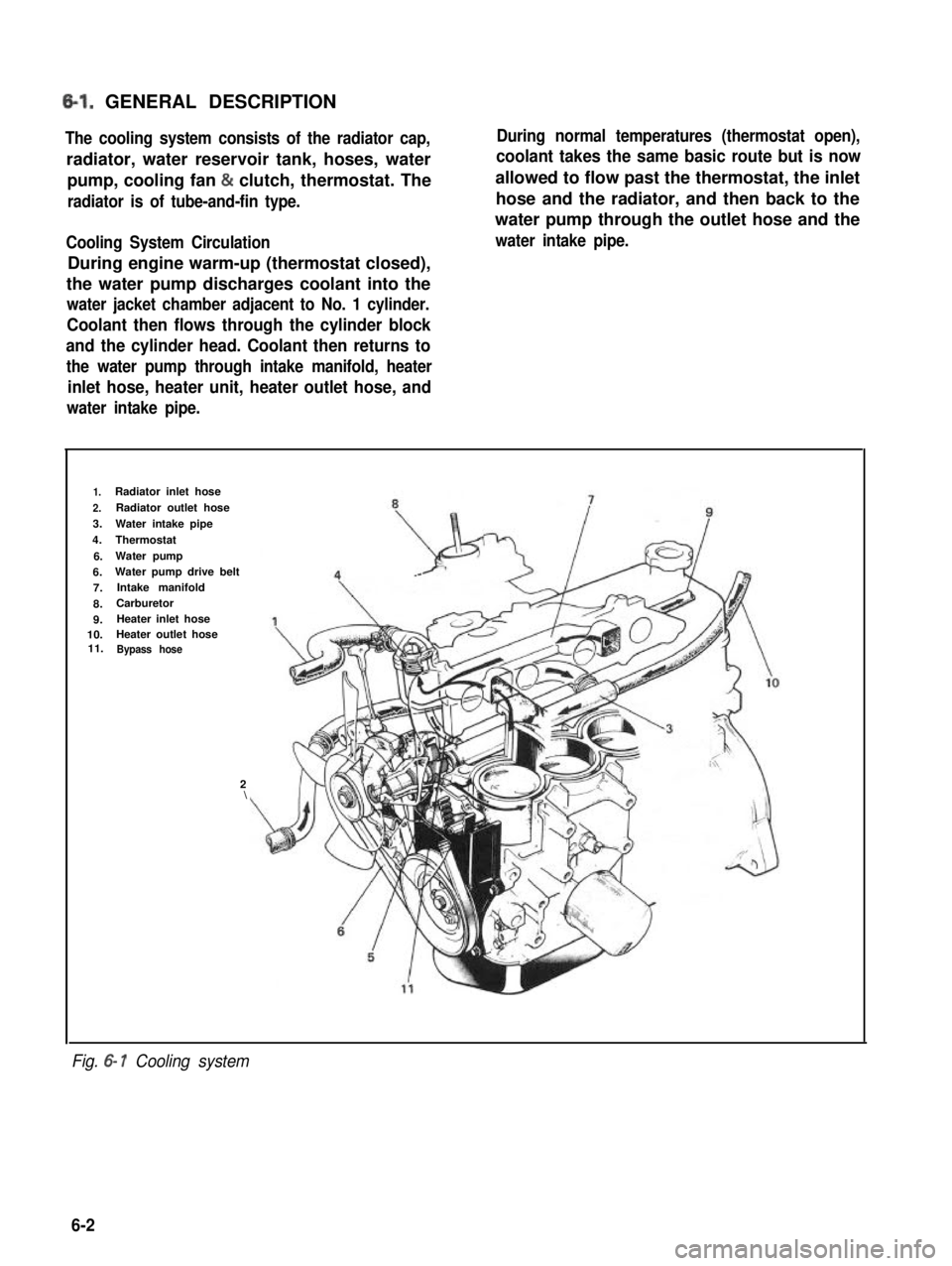1987 SUZUKI GRAND VITARA heater
[x] Cancel search: heaterPage 142 of 962

1. Idle speed adjusting screw
Fig. 4- l-62 Idle speed adjusting screw
4) After idle speed adjustment, check idle-up for
operation with lights (small light, tail light,
side marker light and license light), heater fan
and rear defogger (if equipped) turned “ON”,
only one at a time. Refer to item “Idle Up
Adjustment”. (p. 4-20).
5) Stop engine and check to ensure that accelera-
tor cable play is within the specification as
previously outlined. If play is out of specifica-
tion, adjust it.
Idle Mixture Inspection and Adjustment
[Inspection]
1) Warm up engine to normal operating tem-
perature.
2) Remove seal rubber of duty check coupler
and connect positive terminal of duty meter
to “Blue/Red” wire and negative terminal to
“Black/Green” wire.
1
1. Duty check
3) Set tachometer.
4) Run engine at 1,500 - 2,000 r/min for 30
seconds and bring it to idle speed.
5) Check duty at specified idle speed. If it is out
of specification, adjust it to specification ac-
cording to following adjustment procedure.
Specified DutyIO-50
at 750 - 850 r/min.
After inspection, install seal rubber to duty
check coupler.
[Idle Mixture Adjustment]
The carburetor has been calibrated at the facto-
ry and. should not normally need adjustment in
the field. For this reason, the mixture adjust-
ment should never be changed from the original
factory setting. However, if during diagnosis, the
check indicates the carburetor to be the cause of
a driver performance complaint or emission
failure, or the carburetor is overhauled or
replaced, the idle mixture can be adjusted using
the following procedure.
After adjustment, mixture adjusting screw pin
must be installed.
Idle mixture adjustment procedure is as follows:
1) Remove carburetor from intake manifold
following normal service procedure to gain
access to mixture adjusting screw pin covering
mixture adjusting screw.
2) Drive out mixture adjusting screw pin using
about 4.5 mm (0.18 in) thick iron rod as
shown below.
1. Mixture adjusting screw pin2. Rod
Fig. 4- l-64 Mixture adjusting screw pin
2. Air intake case
Fig. 4- l-63
4-27
Page 143 of 962

3) Reinstall carburetor following normal service
procedures.
Connect emission control system hoses and
lead wires. Make specified play on accelerator
cable and refill cooling system.
4) Place transaxle gear shift lever in “Neutral”,
set parking brake and block drive wheels.
5) Start engine, and warm it up to normal
operating temperature, stop engine.
6) Be sure to check the following before idle
mixture adjustment.
l Fuel level is within round mark at the
center of level gauge.
l Valve lash is checked and adjusted accord-
ing to the maintenance schedule.
l Air cleaner has been properly installed
and is in good condition.
l All accessories (wipers, heater, lights etc)
are out of service.
l Ignition timing is within specification.
l Choke valve opens fully.
l Idle-up actuator does not operate.
7) Check and adjust idle speed to specification
if necessary.
8) Remove seal rubber of duty check coupler
and connect positive terminal of duty
meter to“Blue/Red” wire and negative
terminal to “Black/Green” wire.
9) Run engine at 1,500 - 2,000 r/min for 30
seconds and bring it to idle speed.
10) With engine running at idle speed, adjust idle
mixture adjusting screw slowly in small incre-
ment allowing time for duty to stabilize after
turning screw to obtain duty of 10 - 50.
If duty is too low, back screw out; if too
high, screw it in. After obtaining duty of
10 - 50, recheck idle speed, and adjust if
necessary.
NOTE:
If adjustment can’t be made because duty meter
indicator does not deflect, check feed back
system according to the checking procedure of
system described in section of Emission Control
System.
11) After adjustment, install seal rubber to duty
check coupler and drive in idle mixture
adjusting screw pin.
4-28
Page 150 of 962
![SUZUKI GRAND VITARA 1987 Service Repair Manual [Fuel tank purging procedure]
WARNING:
This purging procedure will NOT remove
all fuel vapor. Do not attempt any repair
on tank where heat or flame is required, as
an explosion resulting in personal i SUZUKI GRAND VITARA 1987 Service Repair Manual [Fuel tank purging procedure]
WARNING:
This purging procedure will NOT remove
all fuel vapor. Do not attempt any repair
on tank where heat or flame is required, as
an explosion resulting in personal i](/manual-img/20/57437/w960_57437-149.png)
[Fuel tank purging procedure]
WARNING:
This purging procedure will NOT remove
all fuel vapor. Do not attempt any repair
on tank where heat or flame is required, as
an explosion resulting in personal injury
cou Id occur.J
The following procedure is used for purging the
fuel tank.
1) After removing fuel tank, remove all hoses,
fuel level gauge from fuel tank.
2) Drain all remaining fuel from tank.
3) Move tank to flushing area.
4) Fill tank with warm water or tap water, and
agitate vigorously and drain. Repeat this
washing until inside of tank is clean.
Replace tank if inside is rusty.
5) Completely flush out remaining water after
washing.
[ Installation]
Reverse removal procedure for installation using
care for the following.
Tightening torque30-45 Nm
for fuel tank(3.0- 4.5 kg-m)
drain plug(22.0 - 32.5 lb-ft)
Refer to Fig. 4-2-5 for piping and clamp posi-
tions.
l Make sure for correct hose-to-pipe connec-
tion.
l Clamp hoses securely.
l Upon completion of installation, start engine
and check hose joints for leaks.
MAINTENANCE SERVICES
Fuel Lines
Visually inspect fuel lines and connections for
evidence of fuel leakage, hose cracking, and
damage. Make sure all clamps are secure.
Repair leaky joints, if any.
Replace hoses that are suspected of being crack-
ed.
Fig. 4-2-14
Fuel Filler (tank) Cap
Visually inspect gasket of fuel filler cap.
If it is damaged or deteriorated, replace filler cap
with new one.
NOTE:
If cap requires replacement, only a cap with
the same features should be used. Failure to
use correct cap can result in a serious malfunc-
tion of the system.
Fig. 4-2-15
1. Fuel filler cap
2. Fuel filler capgasket
Fuel Filter
As said before, this filter does not permit dis-
assembly: it is to be replaced with a new one
periodically.
Replace fuel filter referring to previous item of
“Fuel Filter Removal and Installation”.
This servicing must be performed in a well
ventilated area and away from any open
flames (such as gas hot water heaters).
4-35
Page 162 of 962

Fig. 5- l-9 ECM
1. ECM
2. Instrument panel.
The ECM sensed parameters are as follows:
l Exhaust Oxygen Concentration.
It is sensed by the oxygen sensor installed on
the exhaust manifold.
1. Oxygen sensor
Fig. 5- I - 7 0Oxygen sensor2. Exhaust manifold
l Engine coolant temperature.
It is sensed by the thermal switch installed on
the intake manifold.
1. Thermal switch
2. Intake manifold
Fig, 5- I- 17Thermal switch
l Throttle position.
It is sensed by the micro switches (wide open
switch and idle switch) installed on the
carburetor.
1. Idle micro switch
2. Wide open micro switch
Fig. 5- 1-12 Micro switches
l Engine speed.
It is computed by the ECM based on the
electrical signal received from the ignition
system.
l Electric load.
The ECM senses electric loads of the follow-
ing items to provide idle speed compensation.
a. Small, tail, side marker, license light.
b. Rear defogger (if equipped).
c. Heater fan.
5-11
Page 178 of 962

1
1. Thermal switch
2. Cool water
3. Thermometer
1. Thermal engine room switch
Fig. 5-3-30 Checking thermal switch in coolFig. 5-3-32 Checking thermal engine room
waterswitch
4) Heat switch to above 46.5”C (116”F), and
check that there is no continuity between
terminals.t
Ll
%I
Rio 0II
I \\1. Hot waterII/2. Heater
Fig. 5-3-31 Checking switch in hot water
5) Reinstall switch to intake manifold. Before
installing, wind sealing tape on its thread.
6) Refill cooling system.
Checking thermal engine room switch
1) Disconnect connector of switch and connect
ohmmeter between terminals on switch side.
2) Make sure that switch is “ON” (ohmmeter
indicates “Zero”ohm) when atmospheric
temperature is below 7°C (44” F) and “OFF”
(ohmmeter. indicates infinity) when above
19.5”C (67” F).
Checking high altitude compensator
Check the compensator as follows:
1) Disconnect the coupler of compensator and
connect an ohmmeter to the compensator.
2) Check to be sure that;
* If the altitude of the place where this check is
performed is above 1,220 m (4,000 ft), the
ohmmetershould indicate“Zero” ohm
(compensator is ON).
0 If the altitude is below 1,220 m (4,000 ft),
the ohmmeter should indicate infinity ohm
(compensator is OFF).
3) After checking, connect the coupler.
1. High altitude compensator
Fig. 5-3-33 Checking high altitude compensator
5-27
Page 186 of 962
![SUZUKI GRAND VITARA 1987 Service Repair Manual [Checking idle-up signal]
The idle-up system operates when any of the small lights (such as tail light, side marker light and license
light), heater fan and rear defogger is put in operation. If the i SUZUKI GRAND VITARA 1987 Service Repair Manual [Checking idle-up signal]
The idle-up system operates when any of the small lights (such as tail light, side marker light and license
light), heater fan and rear defogger is put in operation. If the i](/manual-img/20/57437/w960_57437-185.png)
[Checking idle-up signal]
The idle-up system operates when any of the small lights (such as tail light, side marker light and license
light), heater fan and rear defogger is put in operation. If the idle-up actuator fails to operate even when
any of such equipments is put in operation, check if signal is sent to the ECM according to the following
procedure.
1) Disconnect the coupler from the ECM.
2) Turn ON the ignition switch but don’t run the engine.
3) Connect a voltmeter between the @ terminal and the body (ground) as shown in below figure. If the
voltmeter indicates 11 - 14V when each equipment is operated individually, it means that idle-up
signal is sent to the ECM.
If the voltmeter does not indicate 11- 14V, the particular circuit is disconnected or in poor contact.
Check the circuit for such conditions.
4) After checking, connect the coupler to ECM securely.
1.Coupler
2. 3.Small Heater lights fan
4. Rear defogger (if equipped)5. Ignition switch (ON)6. Battery
7. Br/Y (Brown/Yellow)
4
&
lead wire
Fig. 5-3-46 Checking idle-up signal
5-35
Page 189 of 962
![SUZUKI GRAND VITARA 1987 Service Repair Manual [Bi-metal vacuum switching valve (BVSV)]
NOTE:
For the rough check of the operation, BVSV
can be checked by warming up or cooling down
the engine without being removed from the
intake manifold.
The ch SUZUKI GRAND VITARA 1987 Service Repair Manual [Bi-metal vacuum switching valve (BVSV)]
NOTE:
For the rough check of the operation, BVSV
can be checked by warming up or cooling down
the engine without being removed from the
intake manifold.
The ch](/manual-img/20/57437/w960_57437-188.png)
[Bi-metal vacuum switching valve (BVSV)]
NOTE:
For the rough check of the operation, BVSV
can be checked by warming up or cooling down
the engine without being removed from the
intake manifold.
The check procedure is the same as the follow-
ing except item 11, 2) and 5).
1) Drain cooling system when engine is cold.
2) Disconnect vacuum hoses and remove BVSV
from intake manifold.
3) While keeping BVSV cool (below 53°C
(127” F)), blow nozzle “3”. Air should not
come out of nozzle “4”.
1
2
I
JlrII
Fig. 5-3-53 Checking B VSV 11)
4)‘While keeping BVSV warm
1. BVSV
2. Cool water3. Blow air(nozzle)4. “No air”(nozzle)
5. Thermometer
(above 65” C
(149°F)) in hot water, blow nozzle “3”.
Air should come out of nozzle “4”.
6
Fig. 5-3-54 Checking B VSV (2)
[ EG R modu latorl
1) Check filter for contamination and damage.
Using compressed air, clean filter.
1. EGR modulator
2. Filter
Fig. 5-3-55 Filter of EGR modulator
2) Remove EGR modulator and plug nozzle
with your finger. Blow air into another nozzle
and check that air passes through to air
filter side freely.
1. EGR modulator2. Blow air3. Air filter
Fig. 5-3-56 Checking EGR modulator (1)
1.BVSV
2.Hot water3.Blow air(nozzle)4.Air (nozzle)
5.Thermometer6.Heater
5) Reinstall BVSV to intake manifold. Before
installing, wind sealing tape on its thread.
6) Connect vacuum hoses.
5-38
Page 192 of 962

6-l. GENERAL DESCRIPTION
The cooling system consists of the radiator cap,
radiator, water reservoir tank, hoses, water
pump, cooling fan & clutch, thermostat. The
radiator is of tube-and-fin type.
Cooling System Circulation
During engine warm-up (thermostat closed),
the water pump discharges coolant into the
water jacket chamber adjacent to No. 1 cylinder.
Coolant then flows through the cylinder block
and the cylinder head. Coolant then returns to
the water pump through intake manifold, heater
inlet hose, heater unit, heater outlet hose, and
water intake pipe.
During normal temperatures (thermostat open),
coolant takes the same basic route but is now
allowed to flow past the thermostat, the inlet
hose and the radiator, and then back to the
water pump through the outlet hose and the
water intake pipe.
1.Radiator inlet hose
2.Radiator outlet hose
3.Water intake pipe
4.Thermostat
6.Water pump
6.Water pump drive belt
7.Intake manifold
8.Carburetor
9.Heater inlet hose10.Heater outlet hose11.Bypass hose
2\
Fig. 6- 1 Cooling system
6-2